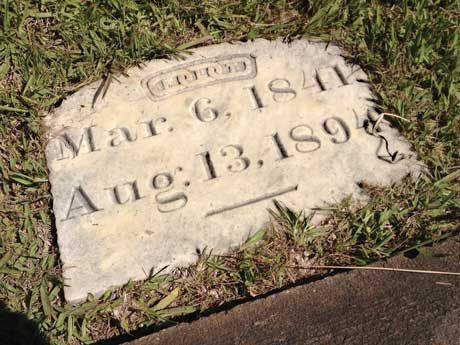
History of the Depot
T. J. Ludwig
Doug Offenbacher
Continuing our review of local personalities in the early days of Los Guilicos (Kenwood), we learn next about a prominent, if not well-documented figure in central Sonoma County history. As with others of moderate celebrity, most of what is known of building contractor Thomas Jefferson Ludwig is the fact of his accomplishments, but little of the man himself.
After a good bit of genealogical digging, we find T. J. Ludwig was a product of Sandusky County, Ohio, born March 6, 1841. Records suggest the Ludwig family was an ambitious group with Ludwig Manufacturing playing prominently in Sandusky history and extensions of the firm showing up in several nearby states over ensuing years. It’s unclear (so far) exactly how T. J. found his way to Sonoma County but once here, he wasted no time in making his mark.
Principally he was a contractor. Many of Sonoma County’s historic landmarks are credited to T. J. Ludwig as builder; some also list him as architect. Santa Rosa’s newest addition to the Railroad Square Historical District, the renovated DeTurk Round Barn, was built by 34-year-old Ludwig in 1875.
One full-page display ad in a San Francisco and North Pacific Railroad publication promoted T. J. Ludwig as a real estate and insurance agent, another ad was for his planing mill and building company at Wilson and 6th Streets near the SF&NPRR tracks in Santa Rosa.
Still it was his reputation as one of the county’s most prolific independent contractors that assured him a place in local history. Among his better known projects was the 79-acre Madrona Knoll Rancho in Healdsburg, five structures of Greek Revival architecture, one of which survives today as Madrona Manor Restaurant.
Another T. J. Ludwig survivor recently returned to a pristine condition is the Mark McDonald home in Santa Rosa. Christened “Mableton,” the home is known today as the McDonald Mansion. Ludwig and Mark McDonald were business associates, though the connection is blurred. McDonald, you’ll recall, was a close friend of Leland Stanford and the Big Four, a fact that would prove beneficial to Ludwig.
Downtown Santa Rosa briefly boasted two Ludwig classics in the form of the marvelous Athenaeum (1884) – a theater in the grandest sense serving up everything from Broadway to Vaudeville to John Philip Sousa, and the majestic Sonoma County Courthouse (1883) – an object of great pride given the historic tug-of-war between Sonoma, Petaluma and Santa Rosa over the honor of being the county seat. Unfortunately both structures were completely destroyed in 1906, victims of the earthquake that left not only San Francisco in ruins, but downtown Santa Rosa as well. Ludwig was roundly criticized for shoddy construction in both cases but his passing 12 years earlier, on August 13, 1894, comfortably spared him that anguish.
The professional portfolio of T. J. Ludwig is far more extensive but we’ll conclude in Sonoma Valley, 1887, and the planned community of Los Guilicos.
The new Santa Rosa & Carquinez Railroad and the Los Guilicos real estate development were both projects of Central Pacific, the Big Four and their close associate, Mark McDonald. Los Guilicos was in need of a depot commensurate with its intended prestige. Duplicating San Carlos, a sister project 100 miles to the south, a stone depot of Romanesque design was chosen and local contractor, T. J. Ludwig was awarded the contract – presumably with a strong recommendation from McDonald. Construction of the N. W. Griswold home and seven railroad bridges across the Decker & Jewett Ranch were also awarded to Ludwig.
We’ll close with a bit of mystery about the man himself. While he did marry, you find nothing of his wife (Mae?) or children (possibly in Cloverdale?)
 |
The headstone of T.J. Ludwig’s grave in Santa Rosa. |
Consistent with men of wealth in that era, there is evidence he bred horses, specifically trotters, and owned ranch land south of Santa Rosa. Consistent with men of power, specifically those with whom he did business, he was a Freemason and a Republican. More than that, if anything of a personal nature exists, I have yet to find it.
It was difficult even to find evidence of his passing and his burial site. Inquiries from Sonoma County to Sandusky, Ohio, finally led to Santa Rosa’s historic Odd Fellows Cemetery on Franklin Avenue. And even then, standing at the Ludwig family plot, I would never have known, had I not come with a record of his birth and death. The man who came to Sonoma County and created a legacy of grandeur, left this world with nothing on his stone but the dates of his journey.
Articles
1. A Quiet Treasure1. Kenwood Depot 125 years of stone standing strong
2. Does the Depot Have a Twin?
3. An impressive family tree
4. Tales and tangents
5. The west was young
6. Charles Allerton Coolidge
7. N.W. Griswold
8. T. J. Ludwig
9. Mark McDonald
10. Some Additions
11. Arthur Brown, Senior
12. Marketing Los Guilicos
13. Discovering Our Sister Station
14. History of the San Carlos Depot